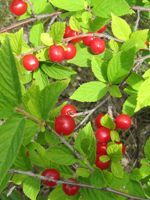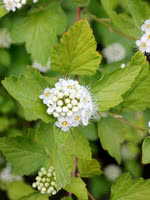Mon-Fri 9am - 5pm Mountain time
Nanking Cherry vs Ninebark
Prunus tomentosa
Physocarpus opulifolius
CUSTOM GROW
Nanking Cherry is a small deciduous shrub known for its attractive white blossoms and edible fruit. Its dark red berries are excellent for pies, jellies, and even fresh eating.
Nanking Cherry is highly regarded as a shade tolerant fruit. We often see it planted as a hedge on the north side of a house where few other plants will survive, let alone thrive.
Expect fruit mid to late July. The fruit can vary in sweetness and size considerably. We often hear that people prefer it to sour cherries. Perhaps this is because Nanking Cherry is more closely related to plums. In fact, it is sometimes used as a dwarfing rootstock for plums.
Ninebark is a small, multi-stemmed shrub, that is used to add texture or colour to any yard.
It features flaky, cinnamon-brown bark, attractive white flowers, and long, maple-like leaves.

